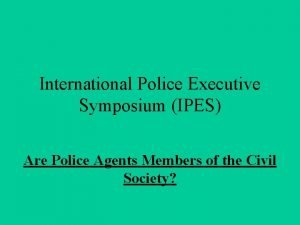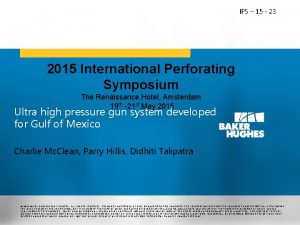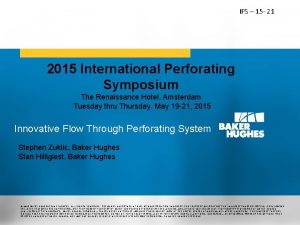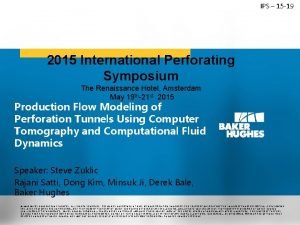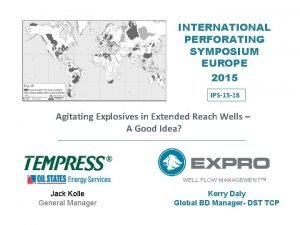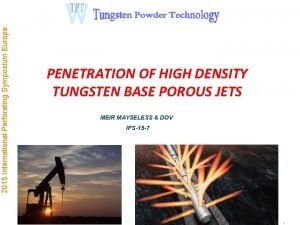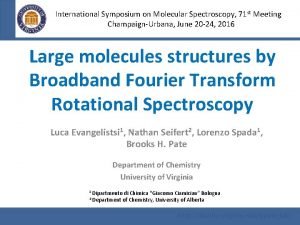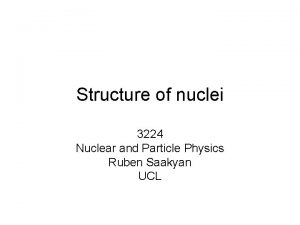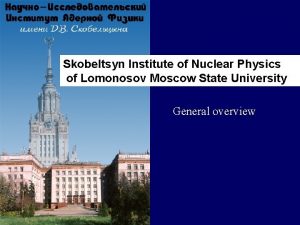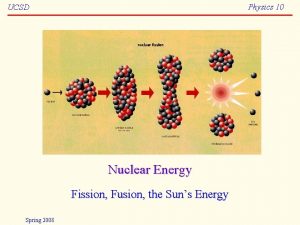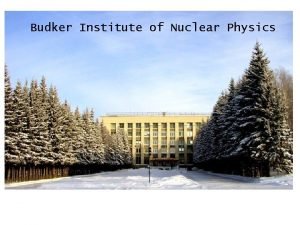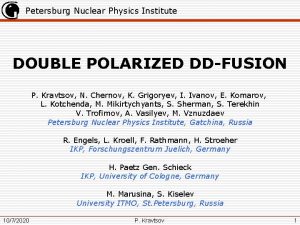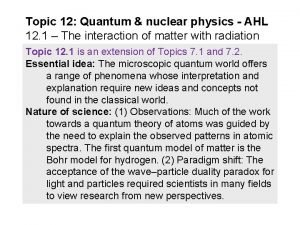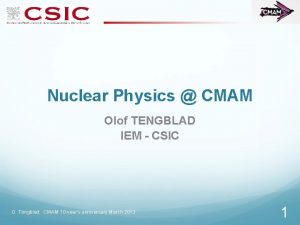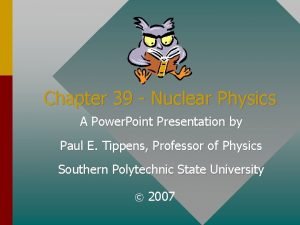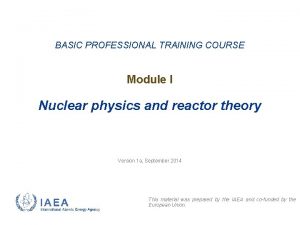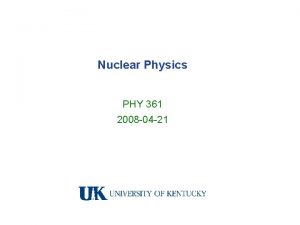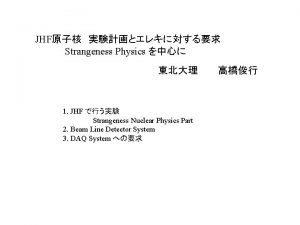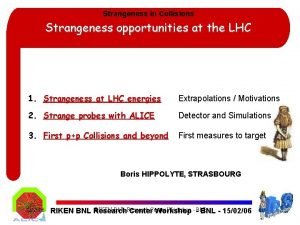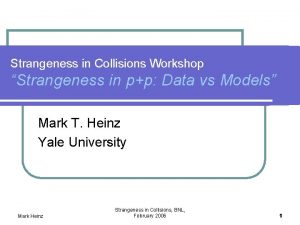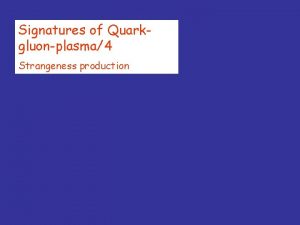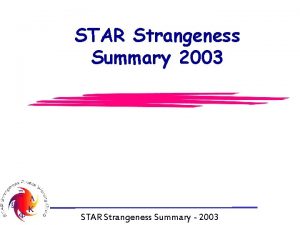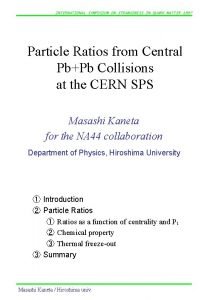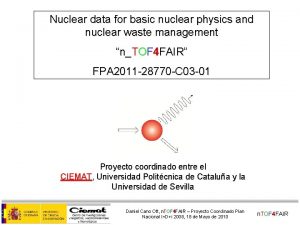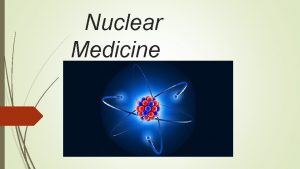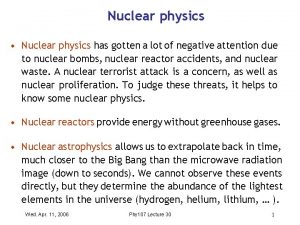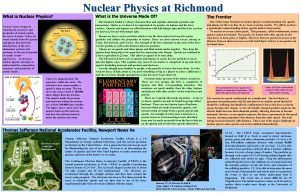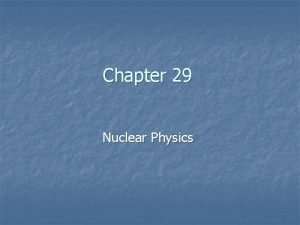2014 International Symposium on Strangeness Nuclear Physics Changsha





















- Slides: 21

2014 International Symposium on Strangeness Nuclear Physics Changsha, China Antiproton beams: a unique tool to study antihyperons embedded in nuclei Josef Pochodzalla Helmholtz-Institut Mainz Institute für Kernphysik Mainz • • • Motivation Antihyperons in nuclei at PANDA Future options

Antihyperons in Nuclei How is g-parity borken? U(p)=-150 Me. V Hans-Peter Dürr and Edward Teller, Phys. Rev. 101, 494 (1956): sign change in coupling constant when going from NN to NN quark picture Cold compression by antibaryons? + +

PANDA – a Factory for strange and charmed YY-Pairs

Exploring (anti-)hyperon interactions Excited particle stable state spectroscopy g-spectroscopy PANDA@FAIR Secondary scattering of momentum tagged hyperons and antihyperons Antihyperons in atomic nuclei

reaching for the unthinkable ANTIHYPRONS IN NUCLEI at PANDA

L Potential exclusive p+p(A) Y+Y close to threshold within a nucleus L and L that leave the nucleus will have different asymptotic momenta depending on the respective potential J. P. , PLB 669 (2008) 306 20 Ne transverse momentum close to threshold of coincident YY pairs p

Gi. BUU Simulations Gi. BUU G-parity used to estimate anti-baryon potentials except for N Approximately 15 k exclusive LL pairs in each set corresponds to ~15 min PANDA incl. efficiency at 107 s-1 Energy (Me. V) Momentum (Me. V/c) Excess energy (Me. V) 850 1522 30. 6 1000 1696 92. 0 Aim of the present work Explore sensitivity of a. T to a scaling of the real Y potential Proof the feasibility of a measurement at PANDA Trigger a fully self-consistent dynamical treatment of antihyperons in nuclei

Gi. BUU 1. 5 https: //gibuu. hepforge. org/trac/wiki G-parity used to estimate anti-baryons potential (except for N) Antiproton potential is scaled by 0. 22 to obtain -150 Me. V

Impact Parameter Free LL production selects peripheral collisions

Rescattering effects

Absorption, rescattering, geometry… Mikroscopic transport models needed

Rescattering & Momentum Distributions longitudinal momentum (Ge. V/c) Is Y –Y pair production at all sensitive to the Y potential ? Test case: L-L production transverse momentum (Ge. V/c)

Scan of L Potential U(L)= -449 Me. V, -225 Me. V, -112 Me. V, 0 Me. V All other potentials unchanged E(p)=850 Me. V L-L

Scan of L Potential U(L)= -449 Me. V, -225 Me. V, -112 Me. V, 0 Me. V All other potentials unchanged E(p)=1000 Me. V L-L

The PANDA detector Antiproton beam Clusterjet or pellet target point Interaction point PID detectors TOF DIRC Muon Forward RICH PWO Caolorimter Forward Shaslyk EMC Micro vertex detector Straw Tube tracker GEM detectors Forard tracking Luminosity monitor Official timeline 2013 -2017: (partial) pre-assembling at COSY, Jülich 2018: first beam expected at FAIR

Antihyperon-Hyperon Pairs in PANDA 2018 first beam in PANDA expected commissioning phase We are right now exploring different scenarios different detector availability different solenoid fields (1 T, 0. 5 T, …) and other important aspects like luminosity length of typical running period Typical (preliminary) LL pair efficiency 3 -5% (better at higher momenta) L+L case nat. Ne target, H for calibration systematic check only charged particle detection easy assume average interactions rate 106 s-1 (~10% of default luminosity) pair reconstruction efficiency ~3% 144 k detected. L+L pairs per day 10 Gi. BUU Moderate data taking period ~14 days Ne target + 7 days p-target 130 present Gi. BUU simulations

Future Options L+SIdeal probe for interactions in the neutron skin 20 Ne; 22 Ne, H for calibration; later: 86 Kr (36 Protons, 50 Neutrons) S- tracking, S- npsimilar production rate (at least in light nuclei) Further options: Any other pair: S-S, X-X, Lc. Lc Long lived resonances in nuclei L(1520) (G= 15. 6 Me. V) X(1530) (G=9. 9 Me. V) Lc(2880) (G=5. 8 Me. V) Unique change to study charmed baryons in nuclear systems ?

Other |s|=1 channels @ 1000 Me. V p+p L+L p+p S 0+L p+n L+Sp+n S++L all antihyperon potentials scaled by same factor E(p)=1000 Me. V S--L

Reactions within the Neutron Skin 1000 Me. V p+20 Ne and p+22 Ne; x(L) = 0. 25 p+p L+L 20 Ne 18808 3667 22 Ne 15733 4516 0. 84 1. 23 22 Ne/20 Ne When going from 20 Ne to 22 Ne p+n L+S- two competing effects more absorption of ingoing p in thicker n-skin less LL and more LSmore absorption of outgoing L in thicker n-skin less LL and less LS- L+S- and L+L production may probe the neutron skin Possibility to explore potentials in neutron-rich environment ?

Stored antiproton beams at FAIR offer several unique opportunities to study the interactions of hyperons and antihyperons in nuclear systems PANDA is an excellent and unique factory for strange and charmed YY pairs The L-L production is an ideal experiment for the commissioning phase of PANDA

 Lesson 15 nuclear quest nuclear reactions
Lesson 15 nuclear quest nuclear reactions Fisión nuclear vs fision nuclear
Fisión nuclear vs fision nuclear International police executive symposium
International police executive symposium International perforating symposium
International perforating symposium International perforating symposium
International perforating symposium Chara screenshot
Chara screenshot International perforating symposium
International perforating symposium International perforating symposium
International perforating symposium International perforating symposium
International perforating symposium International symposium on molecular spectroscopy
International symposium on molecular spectroscopy Quantum and nuclear physics
Quantum and nuclear physics Magic number in nuclear physics
Magic number in nuclear physics Skobeltsyn institute of nuclear physics
Skobeltsyn institute of nuclear physics Nuclear energy in physics
Nuclear energy in physics Scattering cross section in nuclear physics
Scattering cross section in nuclear physics Budker
Budker Petersburg nuclear physics institute
Petersburg nuclear physics institute Physics topic 12
Physics topic 12 Nuclear physics
Nuclear physics Nuclear physics topics for presentation
Nuclear physics topics for presentation Nuclear physics
Nuclear physics Nuclear physics
Nuclear physics


